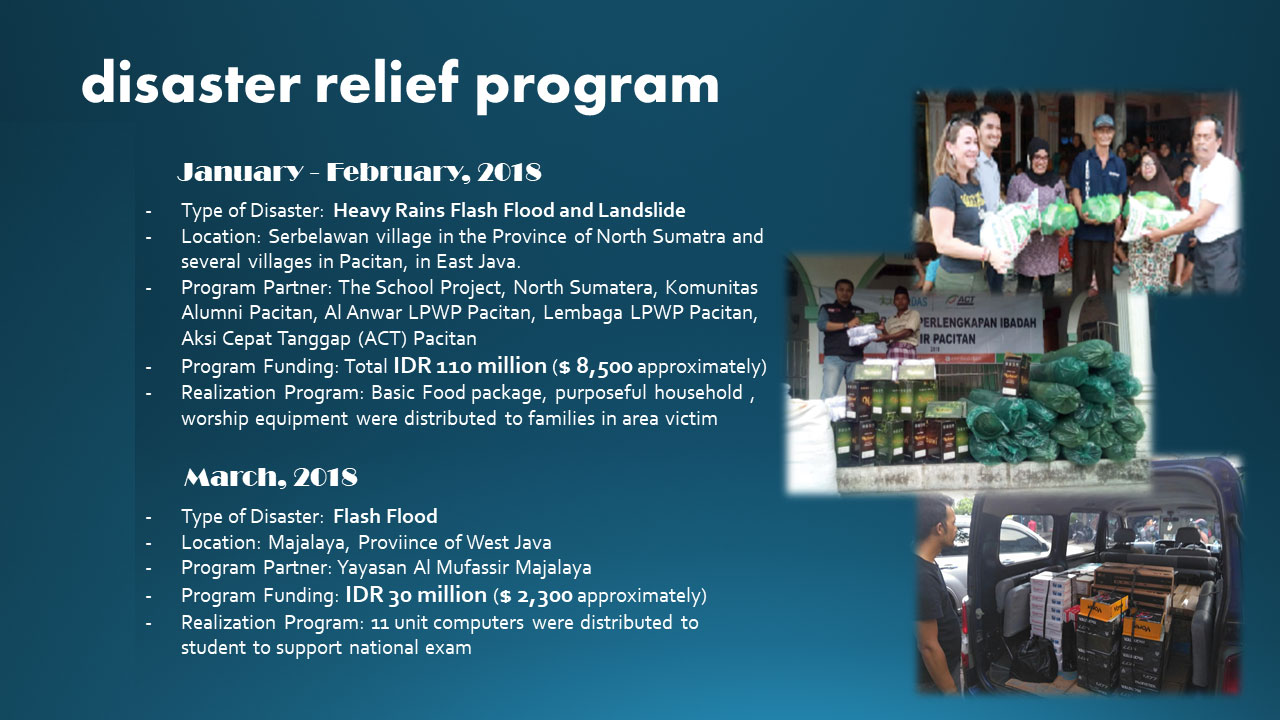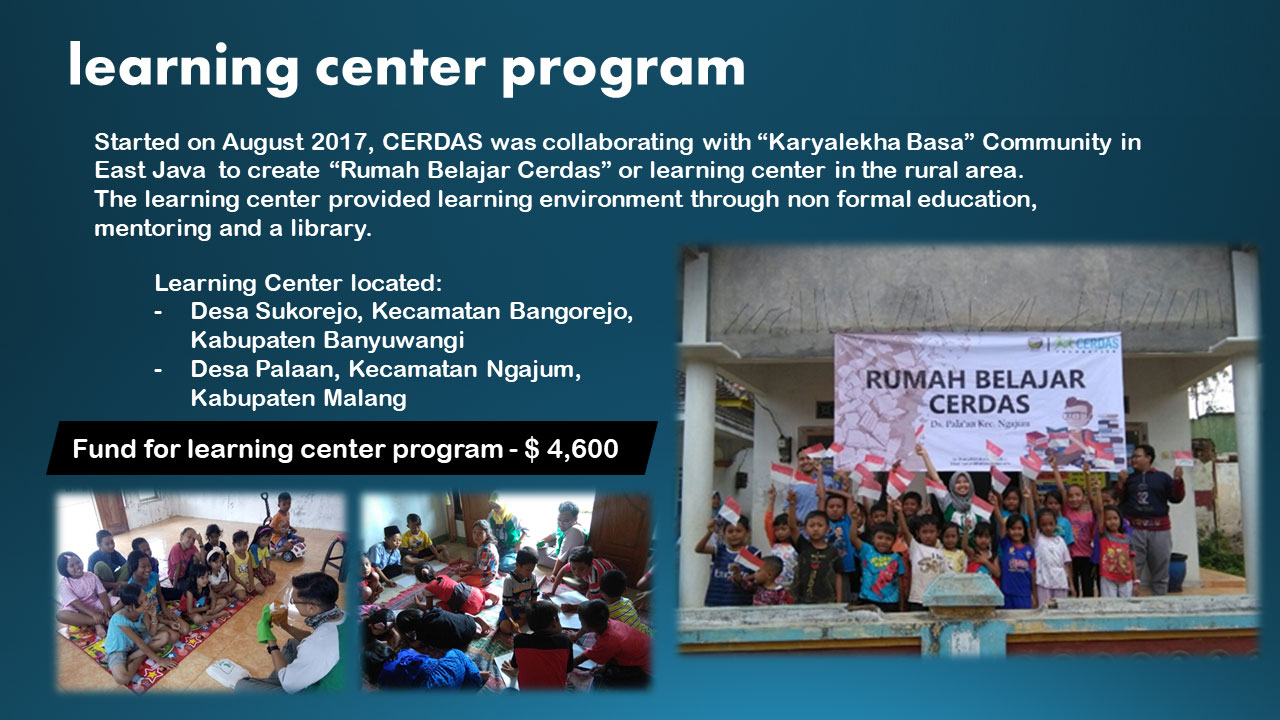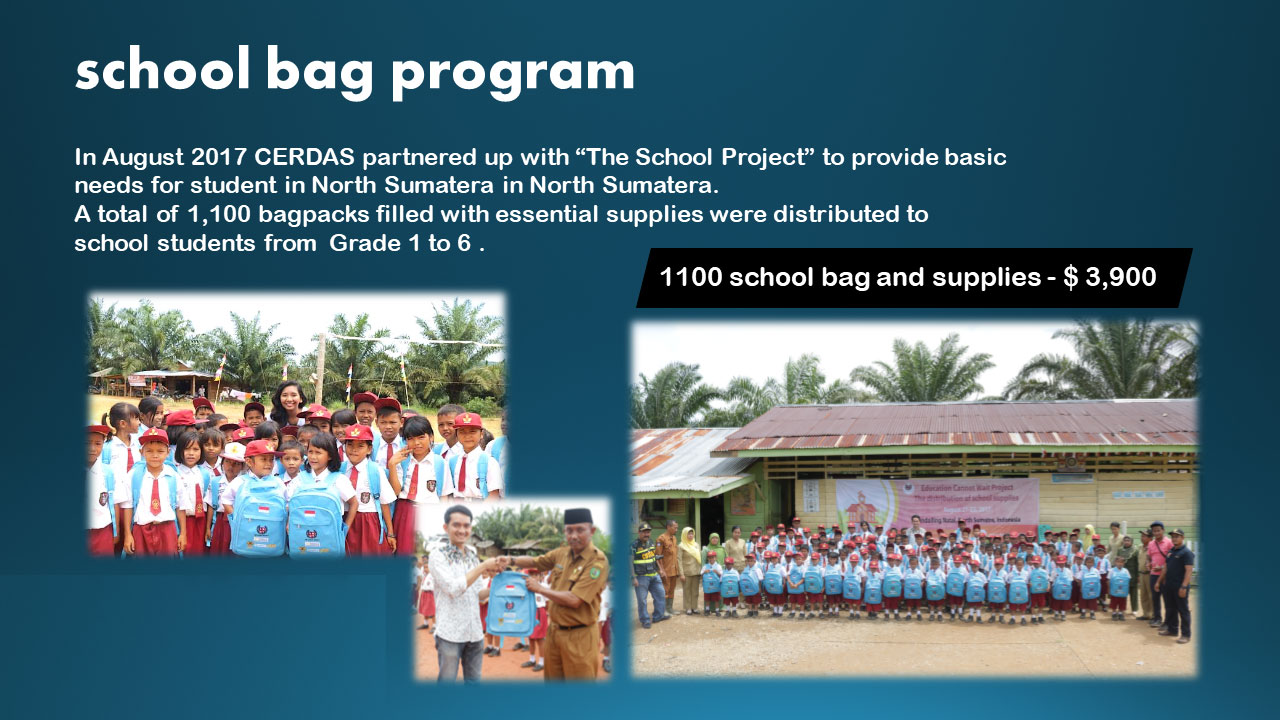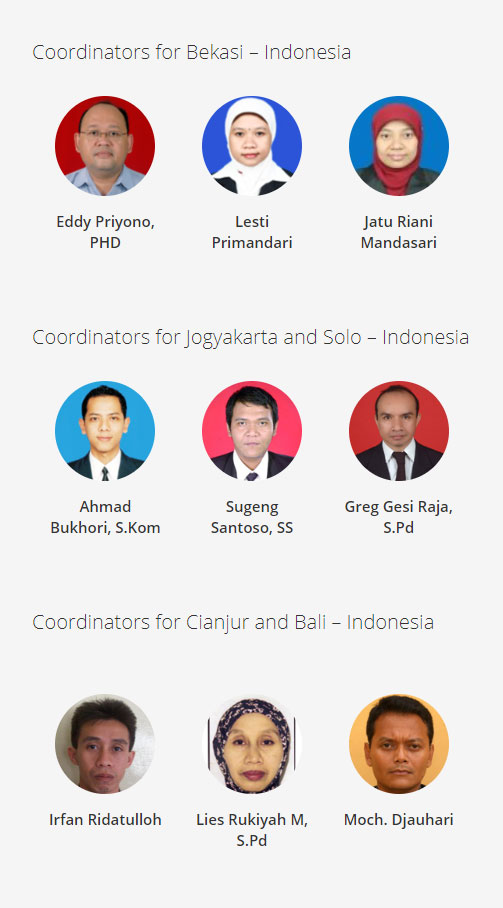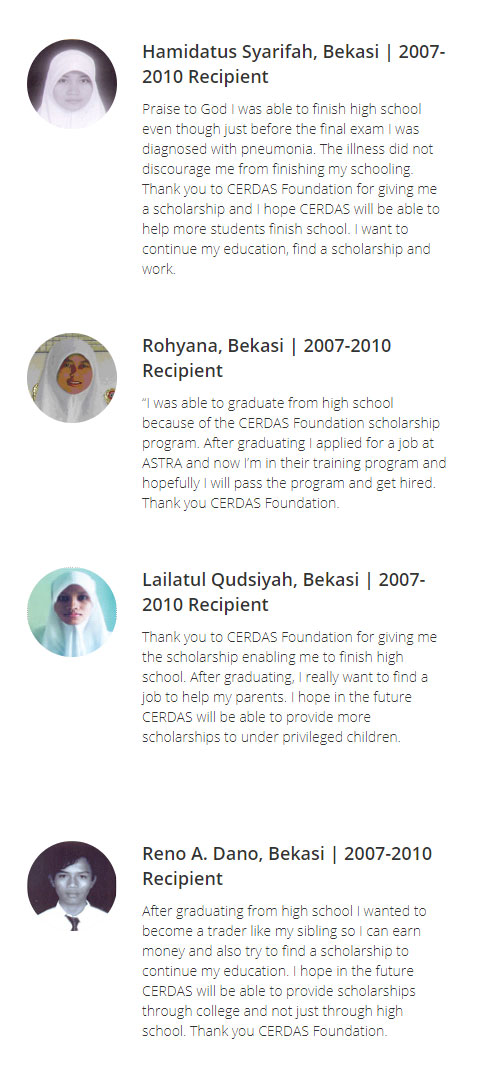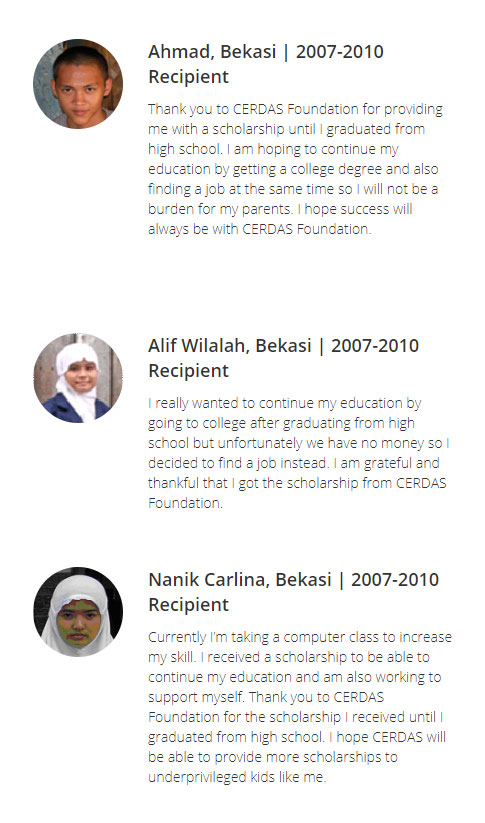Economic barriers often the most important factor that exclude these underprivileged children from educational opportunity in the developing world.

Our program is designed to directly impact the children in need so that they will be able to enroll and remain in school. Our scholarships program is simply aimed to reduce the dropout rate and to improve the transition from primary schools to lower secondary schools. Our scholarship provides students in elementary, middle school, and high school with the basic school needs. Depending on the area of the country, the school level and the need of the student, our scholarship includes: School fees, uniforms, books, and school supplies Support & facilitation (called “pendampingan” in Bahasa Indonesia) as needed The scholarship is carried out for one year. Program evaluation is conducted every year to determine the funding.
Fund a Project
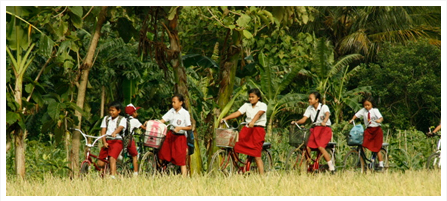
Aside from the cost of education, transportation is another big issue for these families. For those who are able to go to school, the schools are often far away from where the students live so they must travel long distances to get to school and back, which get expensive with the trains and buses.
That is why CERDAS created ”Fund a project” , a special program to help solve some of the transportation issues these students have by giving them a bicycle to use as a means of transportation. This way, the cost of transportation for the student and their family is eliminated and the student can continue going to school without worry. This program is currently being implemented for 10 students in Cilacap.
Community Involvement

As a program intended to respond to the community’s needs, one important element of our scholarship program is community involvement. In our program, we require a community member to work as our field program coordinator – a person who is willing to donate time, labor and money to the program.
As our partners, field coordinators work closely with the students, their families, teachers and school administrators to identify those who are in need and most at risk of dropping out of school due to economic or other hardships in the community. Our field coordinators also work with us on the funding distribution and program administration.
To ensure our program is of the highest quality and meets the needs of the students, we conduct regular monitoring and evaluations of the program in Indonesia and make everything transparent for our supporters to follow our activities.
Program Guidelines
If you are interested in nominating students or becoming our partner in Indonesia, please see our program guidelines. You will be required to sign a contract agreement and fill out program forms.

Where We Work

The main islands are Sumatra, Kalimantan, Sulawesi, Papua, and Java. Indonesia shares Papua with Papua New Guinea and two thirds of the island of Kalimantan with Malaysia and Brunei Darussalam.
There are 33 provinces in Indonesia and three time zones. Across the islands Indonesia encompasses diverse ethnicities and languages but it has one national language called Bahasa Indonesia. Islam is the main religion (88%) making Indonesia the world’s largest Muslim population.
Economic
Recent economic indicators show a positive sign on Indonesia’s economy. The GDP is expected to grow from 4.5% in 2009 to 5.6% in 2010 and the World Bank also estimated a lower poverty rate from 14.2% in 2009 to 13.5% in 2010. Despite recent growth, Indonesia still faces staggering challenges to provide basic resources for its people.
With a total population estimated at 233 million in 2010 (BPS, 2005) and more than one third of them are younger than 20 years, the country faces immediate challenges on education and employment.
Given the country’s wide regional variations in resources and human development achievements, and the fact that approximately 60% of the population live in Java, making the challenges even worse.
Geographical
Being located in a geographical area called the Ring of Fire where large numbers of earthquakes and volcanic eruptions occur presents Indonesia with its most difficult challenges.
The 2004 tsunami that killed and displaced hundred thousands of people and recent 2009 earthquakes in Padang and Tasikmalaya are some of the worst disasters the country ever faced.
In 2009, Human Development Report (HDR) put Indonesia in the 111th rank out of 182 countries, making the country as a medium human development country with a Human Development Index (HDI) of 0.734.
Our Beneficiaries
The children benefitting from CERDAS Foundation’s work come from humble backgrounds. Their families struggle just to make ends meet. Often, the parents themselves came from deprived homes and had little or no education. This limits their earning capacity, which subsequently affects the quality of life they are able to provide for the next generation.
Older children are often forced to leave school to help support their family. Here are some of our beneficiaries. They are the lucky few among the multitude living in poverty who have been given hope for a better future through education:
Our Coordinators
The success of our program could not be achieved without the support of our fieldprogram coordinators in Indonesia. These volunteers help us identify those who are in need and are most at risk of dropping out of school in the community. They also help us with funding distribution and program administration. Learn about these people who are willing to donate their time, labor and even money to the success of our program:
Success Stories
For the 2009-2010 school year, we had 13 students graduate from high school. All of them received a scholarship through CERDAS Foundation from compassionate people like you. Highlights of our scholarship program in 2009-2010 came from two of our students, Andien Diana and Firdha Hanifah, who have been accepted in two prestigious universities in Indonesia.
Andien Diana, who graduated from high school in Bandung has been accepted at the Bandung Institute of Technology, and Firdha Hanifah who graduated from high school in Bogor has been accepted at the Padjadjaran University in Bandung. We thank all of you for helping these children by donating and helping spread the message about CERDAS activities. Thank you all for your generosity. Please read messages from some of those students.
Disaster Relief Program
Our disaster relief program is designed to provide temporary emergency assistance to residents in a disaster area. To distribute the aid, we collaborate with otherrelief organizations or non-government organizations (NGOs) that have access to the affected area. Here are some of the major emergency disaster relief programs we have conducted:
Padang and Tasikmalaya Disaster Relief Program
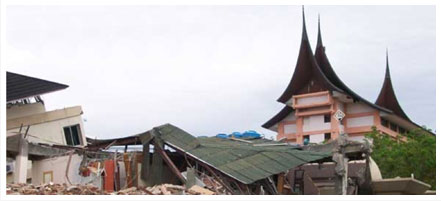
Following two strong earthquakes that struck the city of Tasikmalaya (and the surrounding areas) in West Java and the city of Padang (and the surrounding areas) in West Sumatra, CERDAS launched two urgent appeals to help the people in those areas. We received a generous response from the public and donations to the sum of $14,289.00 have been collected, $1,685.00 for Tasikmalaya and $12,604 for Padang.
These donations have given an immediate relief for people who are in real need in these terrible disasters. For further information regarding our disaster relief program, please see our reports.
Wasior, Mentawai, and Merapi Disaster Relief Program
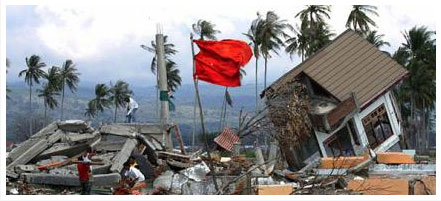
From October to early November, 2010, Indonesia was hit with three deadlynatural disasters in the Wasior, Mentawai, and Merapi regions. Toprovide aid to those who were impacted by these disasters, CERDAS sentout an urgent appeal for help, and you all responded. We were able toraise $5,645.00 with donations coming in from all across the UnitedStates. The money was then sent to Indonesia where it was distributedto those in need.
The Wasior region was handled by Romo Y. Rumanto,the Mentawai region was handled by the Indonesian Red Cross, Mentawaibranch, and the Merapi region was handled by hoshiZora.org.From those in Indonesia and here at CERDAS, we thank you all for your help.
